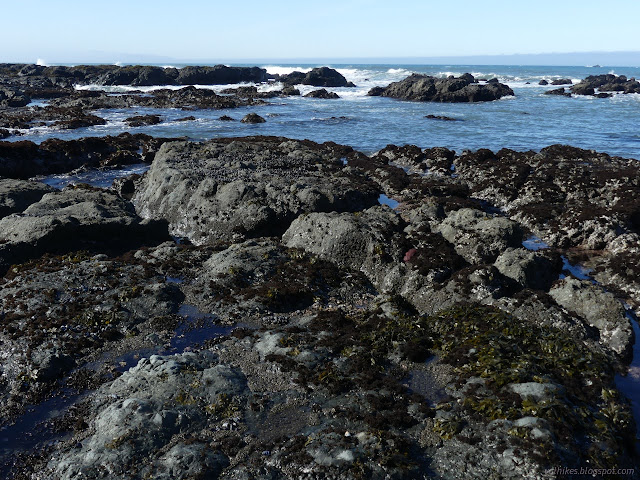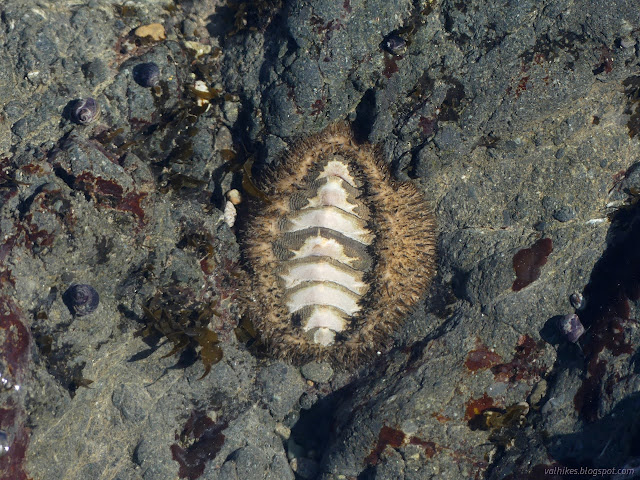Lost Coast: Punta Gorda Lighthouse
King Range National Conservation Area, Arcata BLM
(brown line, map link)
DAY 1 | DAY 2 | DAY 3 | DAY 4 | DAY 5 | DAY 6 | DAY 7
With just a short way to go and since it takes a long time for the sun to get over the hills, I took a while to get started.

In fact, the first hikers of the day came by just after I finished packing and wandered over to the sign about elephant seals. Listening to their strange clacking noises and thinking how I'd now seen them in very different seasons (October before), I wondered when you don't get to see them. The sign promptly answered. August. You don't get to see elephant seals in August. And you might miss them at the end of March. At this time, there should be molting females. I'd seen a few clearly molting and hadn't managed to spot a male. I should have recorded those sounds!

Then I headed back north. There were more hikers coming south as I took the trail back to Fourmile Creek. I crossed on a log near the cliffs, but the tide was out far enough to make some rock hopping opportunities down by lapping waves. Since I went straight to those rocks to start exploring their secrets, even crossing back over a little of the creek, I might as well have tried the rock hopping.


And so I wandered slowly along the rocks making the distance much longer than it needed to be with excursions out to the breaking waves, then back to the sand and pebbles. I kept on this way until passing the northern trail up to Windy Point. Some of it was just sand, at least at that tide level. The low wouldn't be until noon.









There's trails through the sand dunes north of the north trail to Windy Point. I had taken the beach on the way out, so I took the trails among the dunes on the way back.






I passed by backpackers, all in groups of 2 or 3, for a total of 15 ready to head south on the beach for the weekend. I got to the parking lot around noon where another 12+ (I lost count) of an organized group were just getting started to do the same. The trailhead had changed a little. Current tide charts had been added, the map box was full of big, beautiful, free maps, and two port-a-poties had been added to prepare for the greater numbers of people coming in the summer.
Oh, and a flopping piece of paper had been replaced by a laminated sheet about a proposed fee change. They want to increase fees to $12 per person, per trip for overnight wilderness use. My permit was $6, which can cover up to 3 people for the same overnight use. That's a reservation fee going to the reservation system, so this change might mean triple the cost for me. Or double. It's not clear. On the one hand, it's just making it that much more inaccessible to the poorer of us. On the other, I drove from the nearest "big" city in a small car and the ~$20 of gas is still a bit more than the cost to the folks providing those big, beautiful, free maps.
So I gave my new backpack a bit of a trial by fire by taking it on this trip. First it was subjected to sand for days, then brought up into the hills where it was slashed at from all sides by brush and even dragged in the dirt. The Durston Kakwa 55 in medium took it all and doesn't look any worse for wear. Looks can be deceiving and it was only a week. Still, so far so good.
I took it out on the local 3 mile loop packed up with gear and 2-3 full Platypus water bladders to be the weight of food/water and the hip belt tended to bite in a bit at the bottom. This worried me, but it didn't get any worse over 70 miles of actual gear+foot/water carrying. It would probably be better for me if I could cinch the top a little tighter than the bottom on the hop belt, but I can give the bottom level a pull to loosen it a little with respect to the top and it holds a little on friction. The belt seems to train itself a little. If it starts to press, I can tell it to stop.
Shoulder straps are a bit too wide set for me. The middle puckers up a bit upward, which doesn't cause any bother to me. Either because they are S-straps rather than J or because they are nice and wide, I didn't feel the need to hunch my narrow shoulders inward to hold the straps in place, even without latching the sternum strap. (Don't like sternum straps.) Some past pack encouraged this and it causes pain eventually, so that's nice.
Bear canisters are required in the King Range. My BV500 fit inside across the top perfectly, which is my preferred placement. The pack description advised that it might be just a little too tight for this particular bear can. Sometimes I did only fold the top around twice before latching it.
While there is a hole for a hydration system tube (so small you have to take the bite valve off to get it through), there is no pocket for a bladder. I didn't see any problem with this since I can just stuff it down where the pocket is usually placed and all the other gear squeezing it keeps it in place. However, that pocket was also organization keeping my dirty water bag, extra clean bag for camping water, scoop, laundry bag if I've got it, maybe filter and cleaning syringe all collected. That stuff migrates all over in packing and unpacking and was irritating sometimes. Sometimes the bear can interfered with the tube, so I had to pay a little attention when I dropped it in on top.
I filled up my pockets with various things. The extra side pocket and hip belt pockets can be secured, but none of the others. I didn't manage to lose anything, but it's hard not to put that down to luck. Just you wait, something will get plucked out by a bush.
My back got hot even though I was generally a little bit cold. There's a thin layer of padding across it all that felt particularly good at retaining heat. Sometimes it felt oppressive and sometimes I didn't really notice until a bit of sweat dripped even though the rest of me wasn't even thinking of sweating. My favorite pack based on how my back felt was still one that didn't even put mesh against me and thus truly ventilated. Maybe I have the capacity to ignore this, but as spring and summer wears on, it might be my greatest complaint. Yep, even more than having to tell the hip belt to stop digging into my butt.
But it carried the weight (max it has seen is still 10 pounds below suggested maximum weight) and didn't leave me feeling hurt. Prodded, but not hurt. Overall, very workable, with a solid frame and under 2 pounds by itself.
*Lost Coast album*
©2023 Valerie Norton
Written 26 May 2023
Liked this? Interesting? Click the three bars at the top left for the menu to read more or subscribe!





Comments